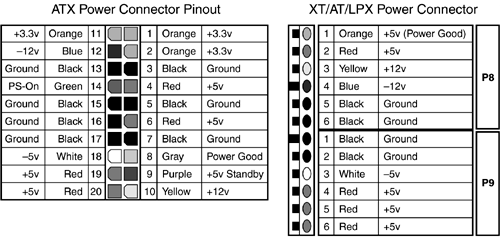Power Supply Ratings
| < Day Day Up > |
| In previous chapters, you've learned about bits, nibbles , bytes, base 2, base 10, and base 16. Here's another measurement for you: watts. There are all types of complex calculations for watts, but they aren't important in this case. What is important to realize is that power supplies are rated in watts, and the more watts a power supply provides, the more devices it can safely power. Typically, power supplies in tower-case (upright case) machines use 300-watt or larger power supplies, reflecting the greater number of drives and cards that can be installed in these computers. Power supplies used in smaller desktop computers have typical ratings of 145 watts or less. The power supply rating is found on the top of the power supply, along with safety rating information and amperage levels produced by the power supply's different DC outputs. caution
If you have a processor that runs faster than 1GHz, a mid-range or high-end gaming 3D card, or multiple hard or optical drives and your power supply is under 300 watts, you're just asking for trouble. Fast processors and 3D graphics cards along with multiple drives are notorious power munchers. What happens if you connect devices that require more wattage than a power supply can provide? A big problem we call an overload . An overloaded power supply has two major symptoms:
caution
Here's a good rule of thumb: If your system starts spontaneously rebooting, replace the power supply as soon as possible. However, power supply overheating can have multiple causes; follow the steps listed in the section "Causes and Cures of Power Supply Overheating," later in this chapter, before replacing an overheated power supply. To determine whether Power Good or other motherboard voltage levels are within limits, perform the measurements listed in the section "Determining Power Supply DC Voltage Levels" later in this chapter. |
| < Day Day Up > |
EAN: N/A
Pages: 310
